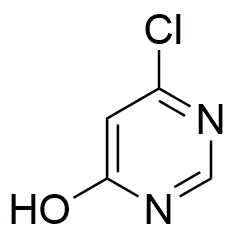4-Chloro-6-hydroxypyrimidine is widely utilized in research focused on:
- Pharmaceutical Development: This compound serves as a key intermediate in the synthesis of various pharmaceuticals, particularly those targeting viral infections and cancer. Its unique structure allows for modifications that enhance biological activity.
- Agricultural Chemicals: It is used in the formulation of herbicides and fungicides, helping to protect crops from pests and diseases. This application is crucial for improving agricultural yields and ensuring food security.
- Biochemical Research: Researchers employ this compound in studies related to nucleic acids and enzyme interactions, providing insights into genetic processes and potential therapeutic targets.
- Material Science: The compound is explored in the development of novel materials, including polymers and coatings, due to its ability to impart specific chemical properties and stability.
- Analytical Chemistry: It is utilized as a standard in various analytical techniques, aiding in the quantification and detection of related compounds in complex mixtures.
Informations générales
Propriétés
Sécurité et réglementation
Applications
4-Chloro-6-hydroxypyrimidine is widely utilized in research focused on:
- Pharmaceutical Development: This compound serves as a key intermediate in the synthesis of various pharmaceuticals, particularly those targeting viral infections and cancer. Its unique structure allows for modifications that enhance biological activity.
- Agricultural Chemicals: It is used in the formulation of herbicides and fungicides, helping to protect crops from pests and diseases. This application is crucial for improving agricultural yields and ensuring food security.
- Biochemical Research: Researchers employ this compound in studies related to nucleic acids and enzyme interactions, providing insights into genetic processes and potential therapeutic targets.
- Material Science: The compound is explored in the development of novel materials, including polymers and coatings, due to its ability to impart specific chemical properties and stability.
- Analytical Chemistry: It is utilized as a standard in various analytical techniques, aiding in the quantification and detection of related compounds in complex mixtures.
Documents
Fiches de données de sécurité (FDS)
La FDS fournit des informations de sécurité complètes sur la manipulation, le stockage et l’élimination du produit.
Spécifications du produit (PS)
Le PS fournit une description complète des propriétés du produit, notamment sa composition chimique, son état physique, sa pureté et les exigences de stockage. Il détaille également les plages de qualité acceptables et les applications prévues du produit.
Certificats d'analyse (COA)
Recherchez des certificats d'analyse (COA) en saisissant le numéro de lot du produit. Les numéros de lot et de lot se trouvent sur l'étiquette d'un produit, après les mots « Lot » ou « Lot de fabrication ».
Numéro de catalogue
Numéro de lot/série
Certificats d'origine (COO)
Ce certificat d'exploitation confirme le pays dans lequel le produit a été fabriqué, et détaille également les matériaux et composants utilisés et s'il est issu de sources naturelles, synthétiques ou autres sources spécifiques. Ce certificat peut être requis pour les douanes, le commerce et la conformité réglementaire.
Numéro de catalogue
Numéro de lot/série
Fiches de données de sécurité (FDS)
La FDS fournit des informations de sécurité complètes sur la manipulation, le stockage et l’élimination du produit.
DownloadSpécifications du produit (PS)
Le PS fournit une description complète des propriétés du produit, notamment sa composition chimique, son état physique, sa pureté et les exigences de stockage. Il détaille également les plages de qualité acceptables et les applications prévues du produit.
DownloadCertificats d'analyse (COA)
Recherchez des certificats d'analyse (COA) en saisissant le numéro de lot du produit. Les numéros de lot et de lot se trouvent sur l'étiquette d'un produit, après les mots « Lot » ou « Lot de fabrication ».
Numéro de catalogue
Numéro de lot/série
Certificats d'origine (COO)
Ce certificat d'exploitation confirme le pays dans lequel le produit a été fabriqué, et détaille également les matériaux et composants utilisés et s'il est issu de sources naturelles, synthétiques ou autres sources spécifiques. Ce certificat peut être requis pour les douanes, le commerce et la conformité réglementaire.


